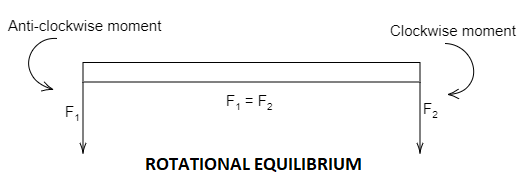
At rotational equilibrium, the sum of clockwise moments equal to the sum of anticlockwise moments.
(A) true
(B) false
Answer
571.2k+ views
Hint:In rotational motion, there are two directions of rotational motion. They are clockwise and anti-clockwise, and the rotational motion is also said to be moment. If the body is in rotational equilibrium, then the clockwise moment and the anti-clockwise moment are equal but opposite in direction.
Complete step by step solution:
Generally, equilibrium is the sum of all the moments that acts in the same object is equal to zero, then only the object is said to be in equilibrium. Rotational equilibrium is defined as the state of a system for which the total angular acceleration is zero. Since it is the torque which is responsible for this acceleration, a total torque of zero is also required for a system to be in rotational equilibrium.

For example, if the rod of some length is hanged with rope and the rope is tied at the exact centre of the rod. So, that the rod hangs horizontally, because the moment of the rod of each side are equal and opposite in direction. If the left side of the rod tries to come down with some moment, the right-side rod will give the same moment but in the opposite direction. So, the rod will hang horizontally. In other words, the sum of all the moments in clockwise is equal to the sum of the moment in anti-clockwise. Then, only the system is said to be in rotational equilibrium.
Hence, the option (A) is the correct answer.
Note: If the sum of the moments in clockwise is not equal to the sum of the moments in anti-clockwise, then the system is not in equilibrium condition. And the moment is directly proportional to the distance, so the distance of the force acting is also the major part in the moment.
Complete step by step solution:
Generally, equilibrium is the sum of all the moments that acts in the same object is equal to zero, then only the object is said to be in equilibrium. Rotational equilibrium is defined as the state of a system for which the total angular acceleration is zero. Since it is the torque which is responsible for this acceleration, a total torque of zero is also required for a system to be in rotational equilibrium.

For example, if the rod of some length is hanged with rope and the rope is tied at the exact centre of the rod. So, that the rod hangs horizontally, because the moment of the rod of each side are equal and opposite in direction. If the left side of the rod tries to come down with some moment, the right-side rod will give the same moment but in the opposite direction. So, the rod will hang horizontally. In other words, the sum of all the moments in clockwise is equal to the sum of the moment in anti-clockwise. Then, only the system is said to be in rotational equilibrium.
Hence, the option (A) is the correct answer.
Note: If the sum of the moments in clockwise is not equal to the sum of the moments in anti-clockwise, then the system is not in equilibrium condition. And the moment is directly proportional to the distance, so the distance of the force acting is also the major part in the moment.
Recently Updated Pages
Why are manures considered better than fertilizers class 11 biology CBSE

Find the coordinates of the midpoint of the line segment class 11 maths CBSE

Distinguish between static friction limiting friction class 11 physics CBSE

The Chairman of the constituent Assembly was A Jawaharlal class 11 social science CBSE

The first National Commission on Labour NCL submitted class 11 social science CBSE

Number of all subshell of n + l 7 is A 4 B 5 C 6 D class 11 chemistry CBSE

Trending doubts
What is meant by exothermic and endothermic reactions class 11 chemistry CBSE

10 examples of friction in our daily life

One Metric ton is equal to kg A 10000 B 1000 C 100 class 11 physics CBSE

1 Quintal is equal to a 110 kg b 10 kg c 100kg d 1000 class 11 physics CBSE

Difference Between Prokaryotic Cells and Eukaryotic Cells

What are Quantum numbers Explain the quantum number class 11 chemistry CBSE




